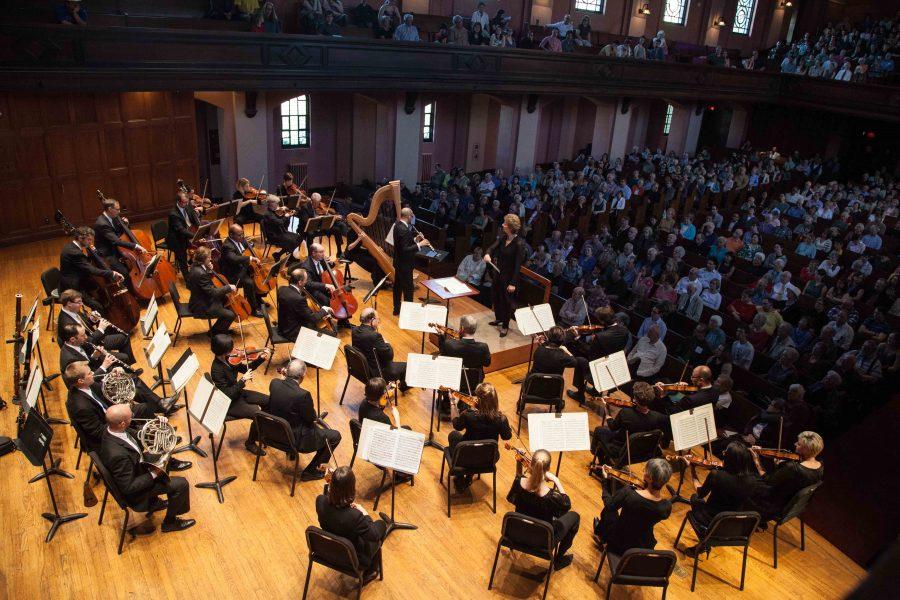Cleveland Orchestra Drags its Way to Strong Finish
Jane Glover conducts the Cleveland Orchestra in Finney Chapel Sunday. The concert’s program featured renowned compositions by Haydn and Mozart.
April 22, 2016
In a quintessentially Classical concert, The Cleveland Orchestra visited Finney Chapel Sunday with two enlightening hours of Haydn and Mozart, played to a nearly full house. Despite several imperfections and a tiring selection of typically Classical pieces, the event was ultimately worth the price of admission.
The Classical era of European music was dominated by the styles and structures of Haydn, Mozart and early Beethoven. These composers relied on simple harmonies, reserved dynamics, elegant melodies and a nearly inescapable standard form of composition. As a result, music from this era has traditionally been perceived as formulaic and simple when compared to the expressive and complex Romantic period that followed. One need only compare the 106 complete symphonies of Haydn to the six written by Romantic composer Tchaikovsky to understand the different mentalities of each era.
In modern times, programs that rely too heavily on these works risk becoming predictable regardless of the quality of the performers. At Sunday’s concert, the audience was faced with this exact problem. The event began with a full Haydn symphony, followed by a Mozart concerto and concluding with an end-to-end Mozart symphony. On paper, this seems like a lot, and it was. Following the conclusion of each major work, noticeable swaths of people left the building. Though the crowd never fell below 60 percent of the chapel’s full capacity, it became abundantly clear that certain listeners were sated long before the main course arrived.
Beginning with the Haydn was the orchestra’s first mistake. Underwhelming from the outset, the first movements of Symphony No. 6 (“Le Matin”) in D Major lacked much of anything interesting. The melodies were clean, with occasional sections in which major themes flowed seamlessly from violin to cello and back again. Certain episodes were even riveting, such as the flute flourishes of the first movement that ripped through the sonorous string section and a deviously unnerving bassoon passage which lingered through the third movement. But these were exceptions — the majority of the first three movements lacked distinction aside from the basic aural pleasure Haydn’s music inspires.
It wasn’t until Haydn’s finale that the orchestra’s spirit came out of hiding. Firm horns and a reinvigorated woodwind section brought diversity to the string-heavy symphony, and conductor Jane Glover bounced to scales and arpeggios performed in contrary motion to one another while new countermelodies complemented those introduced mere moments prior. It was as if the orchestra saved all of its energy for this finale.
Mozart’s Concerto in C major for Flute and Harp, K. 299/297c was the most disappointing work in the concert. Assistant Professor of Harp Yolanda Kondonassis, who is among today’s most recorded classical harpists, couldn’t be heard. It was disappointing that anyone who wasn’t in the rows directly in front of or above her could not fully appreciate her delicate control of the harp, as she was often drowned out by other elements in the ensemble. Especially in the first movement, Kondonassis seemed to almost accompany flautist Joshua Smith when she should have been his equal. At other times, the orchestra entirely covered undoubtedly masterful passages with their playing. By the time balance was established, the work had entered its final movement. Smith’s performance and the support of the orchestra were otherwise excellent, but the fact remains that the harp was the most attractive aspect of this undertaking. Without the benefit of Kondonassis’ full force, the whole performance suffered.
After a much-needed intermission, the remaining members of the audience were greeted with Mozart’s Symphony No. 39 in E-flat Major, K. 543. Unlike the previous two works, this symphony roared out of the gate with gusto. Every aspect of the orchestra seemed livelier — the strings bowed harder, the woodwinds and brass blew faster and even Glover’s conducting evolved from passive bouncing to an involved performance. There was a sense of passion that was mostly absent until this point, and the first movement’s altercation of structural conventions was portrayed with exceptional nuance up until its powerful conclusion.
The second movement converted this electrifying passion into warm themes that smoothly transitioned from one well-coordinated section to another. As melodies built on one another, the audience was treated to a light jaunt full of the vitality of spring. From there, the jovial third movement provided short bursts of energy that somehow remained just as effective as the prior sections. Finally, the symphony concluded in masterful fashion as the fourth movement swiftly scampered along from one powerful attack of sound to another. Like a mine field of key changes waiting to be triggered, each successive burst was unpredictable and thrilling. The symphony sped through tones with confidence and control, constituting a fine conclusion to the concert that easily outshone the preceding works.
The return of The Cleveland Orchestra to Finney was marked by an overreliance on Classical era music that felt overwhelming and exhausting at times. However, despite the balance issues of the double concerto and the lack of enthusiasm during the Haydn, the event concluded in memorable fashion, only exacerbating the wait for next year’s visit.





















